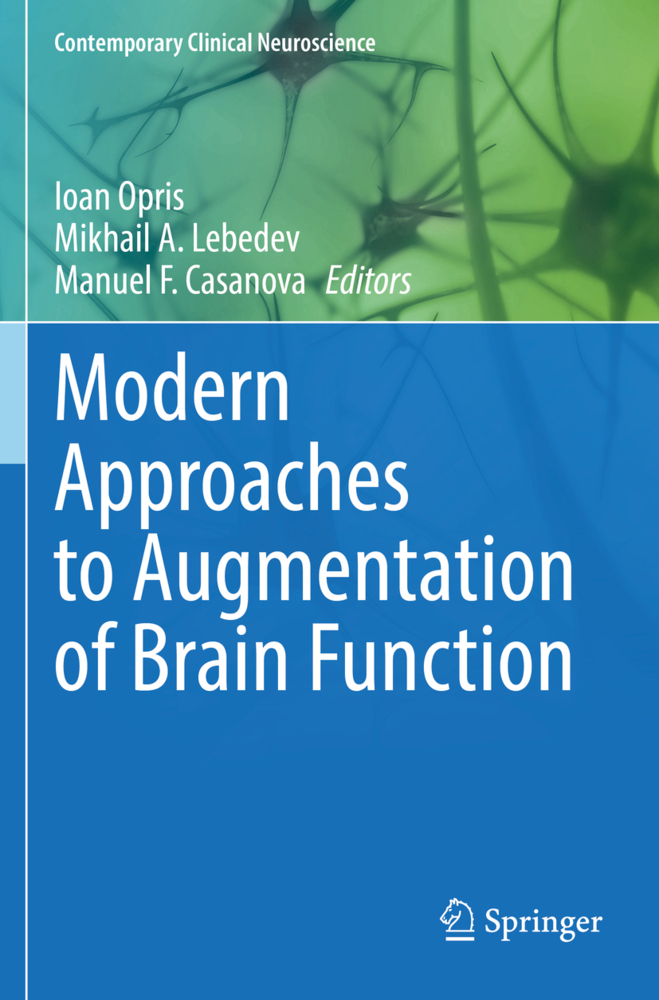Modern Approaches to Augmentation of Brain Function
This book covers recent advances in neural technology that provide for enhancements for brain function. It addresses a broad range of neural phenomena occurring in the brain circuits involved in perception, cognition, emotion and action, that represent the building blocks of behavior and cognition. Augmentation of brain function can be achieved by using brain implants for recordings, stimulation, or drug delivery. Alternative methods include employing brain-machine interfaces, as well as noninvasive activation of certain brain areas. This volume evaluates existing methods of brain augmentation while discussing the brain circuitry and neuronal mechanisms that make augmentation possible.
This volume offers novel insights into brain disorders, and explores new devices for brain repair while also addressing the philosophical and ethical implications of brain augmentation. The information in this book is relevant to researchers in the fields of neuroscience, engineering, and clinical practice.
Advance Praise for Modern Approaches to Augmentation of Brain Function:
"This impressive book by leading experts in neuroscience and neuroengineering lays out the future of brain augmentation, in which the human mind and machine merge, leading to a rapid exponential growth of the power of humanity."
Ray Kurzweil, best-selling author, inventor, entrepreneur and a recipient of the National Medal of Technology and Innovation (1999), and the Lemelson-MIT Prize (2001)
"This book employs a holistic approach in covering the recent advances in the fields of neuroscience, neuroinformatics, neurotechnology and neuro-psycho-pharmacology. Each chapter of the book covers major aspects of modern brain research in connection with the human mind and behavior, and is authored by researchers with unique expertise in their field. "
Ioan Dumitrache, Prof. Dr. Eng. Faculty of Computer Science, Polytechnic University of Bucharest, Bucharest, Romania
"This book presents compelling perspectives on what interactive neuroscience will look like in the future, delving into the innovatory ideas of a diverse set of neuroscientists, and speculating on the different ways computer chips implanted in the brains of humans can effect intelligence and communication."
György Buzsáki, MD, PhD is the Biggs Professor of Neuroscience, NYU School of Medicine, New York, NY
1. Using electrical stimulation to explore and augment the functions of parietal-frontal cortical networks in primates
2. Multi-system benefits of epidural stimulation following spinal cord injury. 3. Neurostimulator for hippocampal memory prosthesis4. Modern approaches to augmenting the brain functions
5. Brain machine interfaces within a critical perspective
6. An implantable wireless device for ECoG and cortical stimulation
7. BCI Performance improvement by special low jitter quasi-steady State VEP paradigm
8. Communication with Brain-Computer Interfaces in Medical Decision-Making
9. Neuroprotection and neurocognitive augmentation by photobiomodulation
10. Avoiding partial sleep - the way for augmentation of brain function
11. Augmentation of brain functions by nanotechnology
12. The impact of ageing and age-related comorbidities on stroke outcome in animal models and humans
13. Diagnostic markers ofsub-clinical depression based on functional connectivity
14. Transcranial magnetic stimulation in autism spectrum disorders: modulating brainwave abnormalities and behaviors
15. Neurofeedback training with concurrent psychophysiological monitoring in children with autism spectrum disorder with comorbid attention deficit/hyperactivity disorder
16. Augmentation through interconnection: brain-nets and telemedicine
17. Cognitive augmentation via a brain/cloud interface
18. Augmentation of neuro-marketing by neural technology
19. Augmentation of nutrition by nanotechnology
20. Neural spintronics: noninvasive augmentation of brain functions
21. Does the power to suppress an action make us free?
22. Deep brain stimulation for Parkinson's disease-future directions for enhancing motor function
23. Neuromodulation for gait
24. Augmentation and rehabilitation with active orthotic devices
25. Effects of rTMS on behavioral and electrocortical measures of error monitoring and correction function in children with autism spectrum disorder
26. Affective Virtual Reality Gaming for Autism
27. A machine learning approach to automatic phobia therapy with virtual reality
28. Vision augmentation by pharmacological enhancement of the visual experience
29. Cognitive enhancing substances and the developing brain: risks and benefits
30. Pharmacological approaches in the augmentation and recovery of brain function.
Opris, Ioan
A. Lebedev, Mikhail
F. Casanova, Manuel
| ISBN | 978-3-030-54563-5 |
|---|---|
| Artikelnummer | 9783030545635 |
| Medientyp | Buch |
| Copyrightjahr | 2021 |
| Verlag | Springer, Berlin |
| Umfang | XXII, 747 Seiten |
| Abbildungen | XXII, 747 p. 189 illus., 153 illus. in color. |


